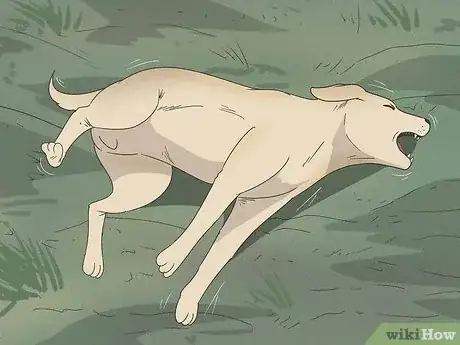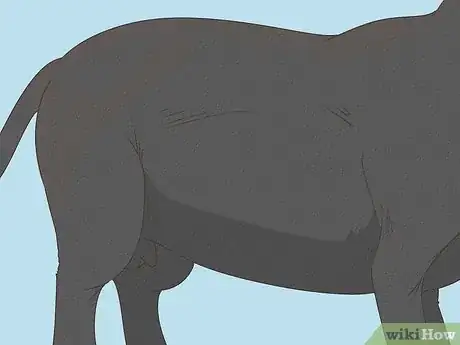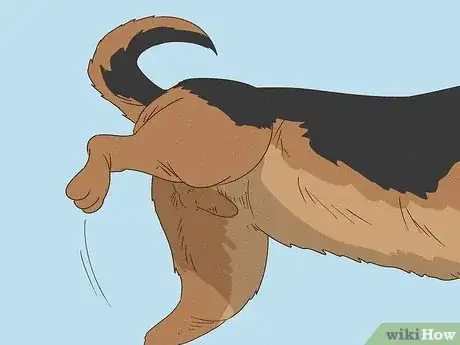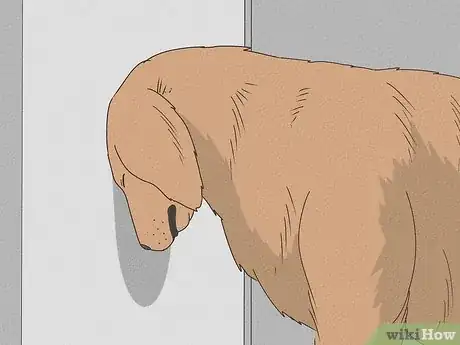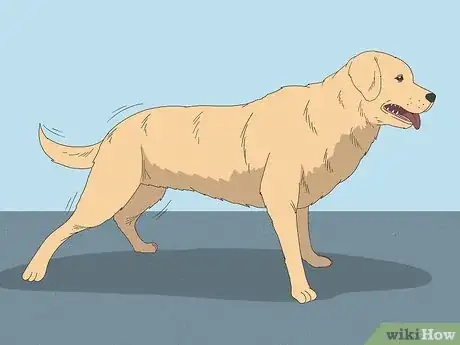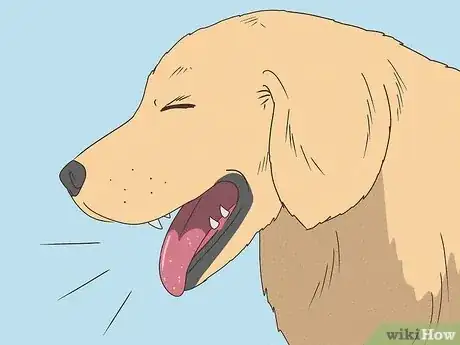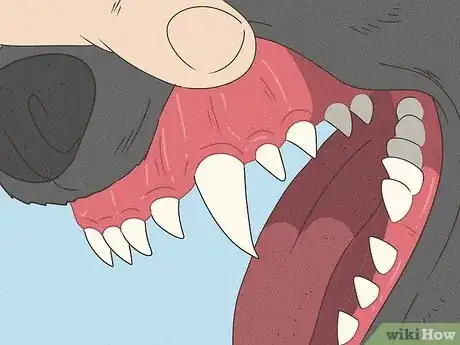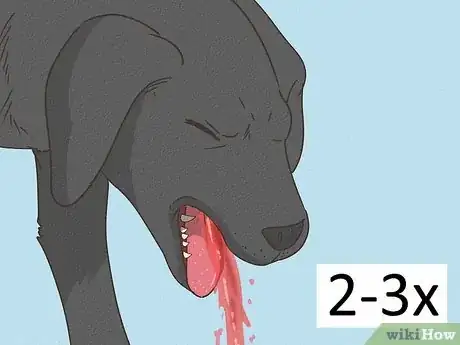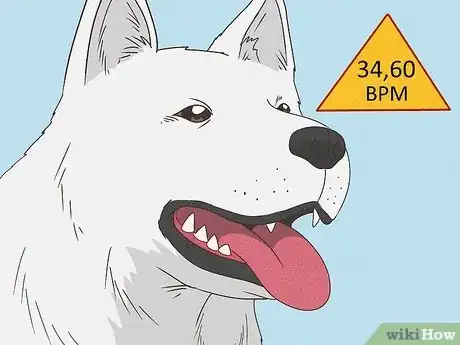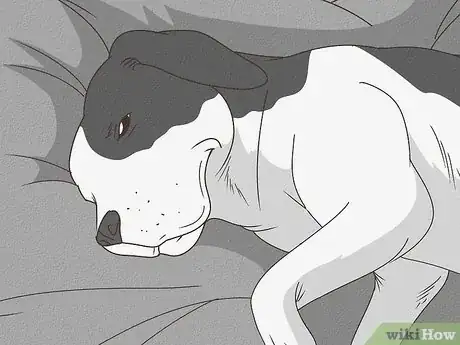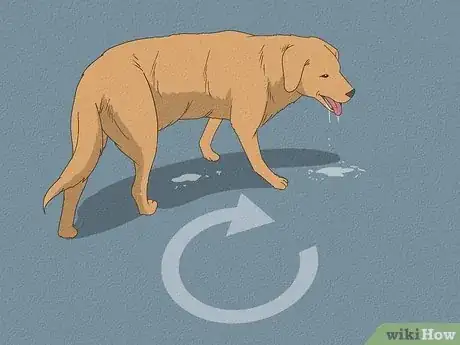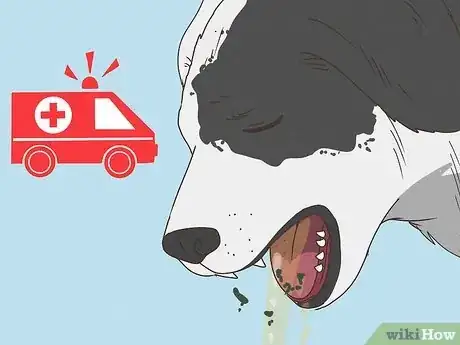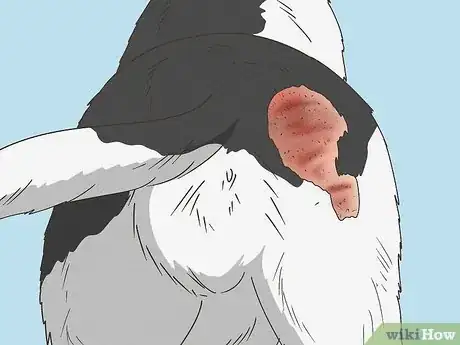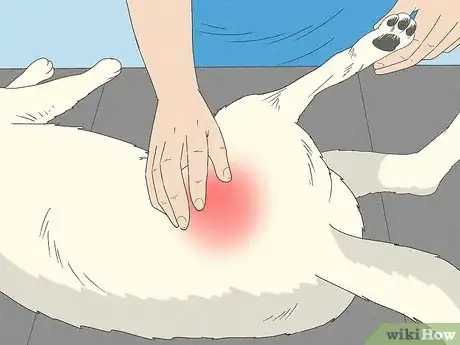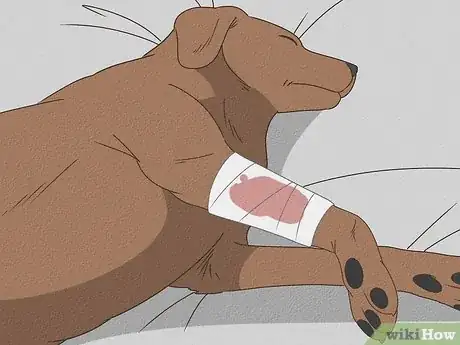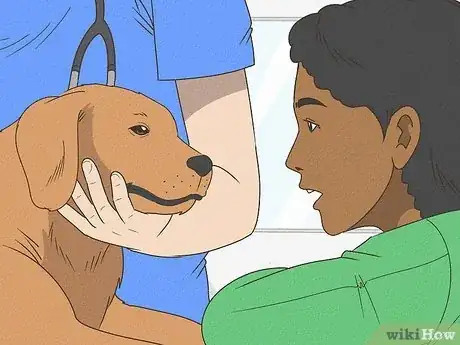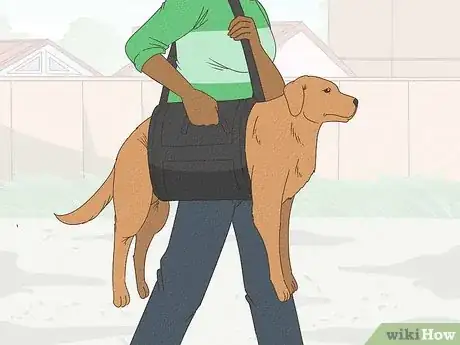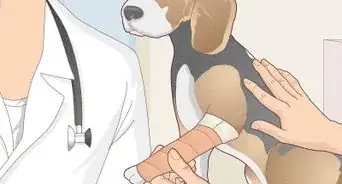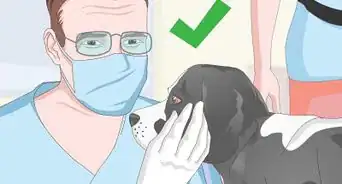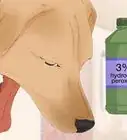This article was co-authored by Natalie Punt, DVM. Dr. Natalie Punt is a Veterinarian and the Founder and CEO of mPet- a smart phone app for pet owners to store, manage and transfer their pets medical records and health information. She specializes in small animal emergency and general medicine and veterinary practice economics. Dr. Punt holds a BS in Biochemistry and Molecular Biology from The University of California, Davis, an MS in Biochemistry from The University at Buffalo, and a DVM from Western University of Health Sciences.
There are 11 references cited in this article, which can be found at the bottom of the page.
This article has been viewed 16,154 times.
If your dog is acting strange or showing signs of sickness, it is never wrong to call your veterinarian. Sick or injured dogs can show a wide range of symptoms, and it can be hard to tell whether a situation is serious is or not. That said, certain symptoms, such as a swollen stomach or fainting, should always receive medical care. Call your vet for advice. If they recommend that you bring your dog in for treatment, transport the dog safely and comfortably.
Steps
Identifying Severe Medical Emergencies
-
1Watch out for fainting, fits, or seizures. If your dog suddenly collapses, faints, or convulses, there is likely something wrong. Any loss of consciousness is a sign of a serious medical condition. Call your vet immediately.[1]
- If your dog is experiencing a seizure, do not touch or move the dog. Move any objects that might fall on or hurt the dog, but do not put your hands or body near its mouth. The dog may bite or injure you.
- If the dog has fainted, drape a blanket over the dog. When you take the dog to the vet, carry it out. Do not drag the dog.
-
2Get immediate medical attention if you notice a swollen or distended belly. A swollen or distended stomach can be a sign of many serious gastric problems. Take your dog to the vet as soon as possible for treatment, especially if the dog is also vomiting.[2]
- A swollen stomach can be a sign of bloat, also known as gastric dilatation. Your dog may also try to vomit repeatedly, sometimes without luck. This is a serious problem that requires emergency attention.
- Internal bleeding can also cause the abdomen to swell. This can cause your dog to go into shock, which may be fatal if untreated.
- It's also possible that the dog has eaten something it shouldn't have, causing an obstruction.
Advertisement -
3Watch for an inability to pass urine despite straining. Signs of straining include repeated lifting of the back leg or squatting. When the dog moves away, the ground is dry. The dog may also lick its genitals excessively, as if attempting to relieve discomfort.[3]
- Not being able to pass urine is a genuine emergency which requires immediate veterinary attention. Failing to do so could result in the bladder bursting, kidney failure, or even a heart attack.
-
4Look for changes in mental status or behavior. Your dog may respond in a bizarre or unusual manner. It might walk into things, press its head against the wall, or not recognize you. Altered mental status can indicate a metabolic or neurological disease. Take your dog to the vet as soon as possible.[4]
- Altered mental status can be difficult to assess, because you need to be able to recognize what is normal for your pet. Changes in normal behavior are usually signs of a medical condition.
-
5Seek veterinary help if your dog is unable to walk. Check to see if the dog is unable to stand, collapses while walking, or walks while dragging its back legs. Whether your dog is old or young, the inability to walk is a sign your dog needs medical care.[5]
- Age, arthritis, pain, and circulatory problems are some of the reasons why your dog may be struggling to walk.
Looking for Symptoms of Sickness
-
1Observe any coughing or wheezing. If you hear constant coughing, wheezing, or noisy breathing for several hours, make an appointment with your vet. If the dog starts coughing up pink foam or froth, take it to the vet immediately.[6]
- Coughing and wheezing can be signs of numerous illnesses. They may indicate a respiratory infection or show that your dog is struggling to breathe.
- If it appears your dog is coughing something up, gently place your fingers in its mouth to see if you can identify what is causing the choking. If you can’t find it, call your vet for advice.[7]
-
2Watch for difficulty breathing. Listen for heavy, long, or loud, labored breathing. The dog may expand its belly to try to fill its chest with air or stretch its neck out as it breathes. These can be signs that your dog is struggling to breathe.[8]
-
3Inspect the color of the dog's gums. Look into your dog’s mouth to check the color of its gums. A healthy dog with well-oxygenated blood usually has bright pink gums. Pale gums may be a sign of sickness. Blue gums are much more serious, as they are a sign that your dog is struggling to breathe.[9]
-
4Monitor your dog if it has been vomiting or experiencing diarrhea. If the dog vomits only 2 or 3 times, wait 24 hours to see if the dog gets better. If there are other symptoms and the dog keeps vomiting for 2-3 hours, call the vet. If there is blood in the vomit or diarrhea, get the dog immediate medical attention.[10]
- Blood in vomit or diarrhea can be a sign of internal bleeding, parasites, or an internal obstruction.
- If your dog has diarrhea or vomiting, give it plenty of fresh water to prevent dehydration.
-
5Identify any foul-smelling discharge from your dog. Discharge from the dog’s eyes, mouth, nose, or genitals can indicate various illnesses, such as pyometra or a cold. If there is a strange or foul odor to the discharge, take your dog to the vet.[11]
- The discharge may be clear, white, yellow, or green in color.
- If you see a clear, odorless discharge from your dog, it may not be a medical emergency, but you may still want to have your vet check it out.
-
6Check for an increased respiratory rate. Count how many times your dog takes a breath in a minute. This is its respiratory rate. A normal respiratory rate is 10-34 breaths per minute. If the dog is resting and its respiratory rate is 60 BPM, it may need medical attention.[12]
- Check its respiratory rate after it has been resting for at least 15-20 minutes. It is normal for your dog to have a higher respiratory rate after exercise or when it is excited. Dogs may also pant if they are happy, stressed, or hot.
- If the dog's respiratory rate is between 34 and 60, keep an eye on it. Check it again after 15-20 minutes to see if it has gone down. If it is still raised, call your vet for advice.
-
7Check your dog's pulse. For this method, you must know what your dog's average heart rate is, since this can vary greatly between dogs. Place your hand over the dog's heart or near the top of its hind legs to feel its pulse. Count how many beats there are in a minute. If it is higher or lower than normal, call your vet for advice.[13]
- To learn your dog's baseline rate, take its pulse a few times while it is healthy. Larger dogs may have a heart rate of 60-100 beats per minute while smaller dogs may have a heart rate between 100-140 beats per minute.
-
8Watch out for weakness or lethargy. Compare your dog’s activity to its normal self. If it is suddenly sleeping or resting more than usual, this can be a sign of an illness or condition. It may also seem depressed, act quieter than usual, or avoid exercise.[14]
- Lethargy alone may not be a sign of a medical emergency, but it can indicate something is wrong.
- There are many reasons why lethargy and weakness may develop, from heart disease to running a fever.
-
9Watch for any unusual restless behavior. If your dog suddenly starts pacing, circling, or moving around frequently, it may be feeling restless. Restlessness alone is not a serious condition. If joined with other symptoms, however, like vomiting or heavy drooling, it may be a sign of a serious condition.[15]
- If your dog is restless while breastfeeding, it may have hypocalcemia (also known as milk fever), a serious condition that needs immediate medical attention.
- If the dog is restless and vomiting, check the stomach for any swelling. If the dog has a swollen belly, see a vet immediately. The dog may have bloat.
Checking Injuries and Other Trauma
-
1Seek immediate veterinary attention if your dog has eaten any toxins. If your dog has ingested poisonous chemicals, paint, poisonous plants, or other toxic substances, take it to the vet immediately. The effects of the toxin will depend on exactly what type of poison it is, how much was eaten, and the dog's size.[16]
- Even if you just suspect that your dog has eaten something bad, get it to the vet just in case. Do not induce vomiting, unless your vet specifically tells you to.
- There are many plants that are dangerous for dogs. These include azaleas, lillies, and tulips. If you find your dog chewing or eating these plants, take it to the vet, even if it is not displaying signs of sickness.[17]
- Signs of poisoning in dogs include vomiting, diarrhea, seizures, nosebleeds, and lack of energy.
-
2Inspect the dog’s fur for signs of a burn or scald. If the dog has come into contact with a hot or burning object, its fur may cover up the burn. If you’re worried about a burn, brush back the dog’s fur gently. Look for signs of redness, peeling, bleeding, or swelling.[18]
-
3Take the dog to the vet after falls, fights, and traffic accidents. Even if your dog appears fine at first, a vet can check for broken bones, bruising, and internal injuries. Handle broken bones carefully until you can get the dog to the vet.[19]
- Even if the dog is able to walk, it is best to treat this as an emergency because pain can push a dog into shock, which can be life-threatening. Signs of shock include pale gums, cold paws and limbs, a weak pulse, and lethargy. These are signs that your dog needs immediate medical treatment.
-
4See the vet if you notice heavy bleeding. Observe any injuries carefully for bleeding. Heavy bleeding may spurt, constantly drip, or soak through a bandage in a matter of minutes. If you can, wrap the dog's wound in a gauze bandage and elevate the wound until you can reach the vet.[20]
- Apply pressure to the wound for several minutes. Non-life-threatening bleeding stops when pressure is applied over the injury, and the bleeding does not resume when the pressure is removed.
- Any bleeding that resumes once pressure is removed should be treated as an emergency.
Acting in an Emergency
-
1Call your vet first to see if you can bring your dog in. Explain your dog’s symptoms and injuries to the vet. Ask them what you should do. The vet may give you advice over the phone or tell you when you can come in to see them.
- If it is outside of your vet’s normal hours, check their website to see if they have an emergency line. Call this number instead.
-
2Take your dog to an emergency vet if your normal vet is unavailable. If you can’t reach your vet or if your vet can’t see your dog right away, find an emergency vet or animal hospital near you. These are open 24-hours a day and usually do not require an appointment.
- While you do not need an appointment, it is a good idea to call the emergency vet if possible to make sure that they have time to see your dog.
- Your vet can refer you to an emergency vet if they can’t treat your dog. In the U.S., you can find a local one here: https://www.aaha.org/pet_owner/about_aaha/hospital_search/default.aspx
-
3Speak to the dog in a soothing voice. During a medical emergency, your dog may be panicked, distressed, or upset. Even the friendliest of dogs may react aggressively towards its beloved owners while sick. Speak to your dog in a soft soothing voice. If the dog will let you touch it, stroke its head and shoulders.[21]
- If the dog snaps, growls, or tries to bite you, try not to touch it as much as possible. Coax it into the dog carrier or car using a treat, toy, or leash.
- If needed, you can make a muzzle out of a belt, gauze, or pantyhose. Wrap it around its jaw, keeping its nose free to breathe.
-
4Carry an injured or immobile dog while transporting it to the vet. Place small dogs in a pet carrier if you have one. Medium and large dogs may need 2 people to carry them through the door. Never drag an injured dog.[22]
- Drape a blanket over the dog to keep it warm while you take it to the vet. If the dog is going into shock, its body temperature may drop.
- Once at the vet, hand the dog over to the veterinarian. They will treat your dog as soon as possible. You may wait in the lobby while the dog is being treated.
- If you don't have someone there to help carry a larger dog, try to pick the dog up from around the chest. If you can't lift the dog, ask a friend to come over or see if the vet will make a house call.
Expert Q&A
-
QuestionWhat are the most common medical emergenciesfor dogs?
 Natalie Punt, DVMDr. Natalie Punt is a Veterinarian and the Founder and CEO of mPet- a smart phone app for pet owners to store, manage and transfer their pets medical records and health information. She specializes in small animal emergency and general medicine and veterinary practice economics. Dr. Punt holds a BS in Biochemistry and Molecular Biology from The University of California, Davis, an MS in Biochemistry from The University at Buffalo, and a DVM from Western University of Health Sciences.
Natalie Punt, DVMDr. Natalie Punt is a Veterinarian and the Founder and CEO of mPet- a smart phone app for pet owners to store, manage and transfer their pets medical records and health information. She specializes in small animal emergency and general medicine and veterinary practice economics. Dr. Punt holds a BS in Biochemistry and Molecular Biology from The University of California, Davis, an MS in Biochemistry from The University at Buffalo, and a DVM from Western University of Health Sciences.
Veterinarian One of the most common medical emergencies for dogs is gastrointestinal foreign bodies—dogs love to eat things they shouldn't, and these items can cause an obstruction in their stomach or intestines. Lacerations from rough play and allergic reactions are other common medical emergencies, too.
One of the most common medical emergencies for dogs is gastrointestinal foreign bodies—dogs love to eat things they shouldn't, and these items can cause an obstruction in their stomach or intestines. Lacerations from rough play and allergic reactions are other common medical emergencies, too.
References
- ↑ http://www.pethealthnetwork.com/dog-health/dog-diseases-conditions-a-z/when-bring-your-dog-er
- ↑ https://vcahospitals.com/know-your-pet/common-emergencies-in-dogs
- ↑ http://www.pethealthnetwork.com/dog-health/dog-diseases-conditions-a-z/when-bring-your-dog-er
- ↑ https://drbillspetnutrition.com/canine-brain-disorders/
- ↑ http://www.pethealthnetwork.com/dog-health/dog-diseases-conditions-a-z/when-bring-your-dog-er
- ↑ http://www.pethealthnetwork.com/dog-health/dog-diseases-conditions-a-z/when-bring-your-dog-er
- ↑ https://www.aspca.org/pet-care/general-pet-care/emergency-care-your-pet
- ↑ http://www.vetstreet.com/care/my-pet-is-breathing-weird-what-should-i-do
- ↑ http://www.pethealthnetwork.com/dog-health/dog-diseases-conditions-a-z/when-bring-your-dog-er
- ↑ http://www.pethealthnetwork.com/dog-health/dog-diseases-conditions-a-z/when-bring-your-dog-er
- ↑ http://www.pethealthnetwork.com/dog-health/dog-diseases-conditions-a-z/when-bring-your-dog-er
- ↑ http://www.pethealthnetwork.com/dog-health/dog-diseases-conditions-a-z/when-bring-your-dog-er
- ↑ http://www.vetstreet.com/dr-marty-becker/check-your-dogs-vital-signs-at-home
- ↑ http://www.pethealthnetwork.com/dog-health/dog-diseases-conditions-a-z/when-bring-your-dog-er
- ↑ https://vcahospitals.com/know-your-pet/common-emergencies-in-dogs
- ↑ https://vcahospitals.com/know-your-pet/common-emergencies-in-dogs
- ↑ https://www.aspca.org/pet-care/animal-poison-control/toxic-and-non-toxic-plants
- ↑ https://vcahospitals.com/know-your-pet/common-emergencies-in-dogs
- ↑ https://vcahospitals.com/know-your-pet/common-emergencies-in-dogs
- ↑ https://vcahospitals.com/know-your-pet/common-emergencies-in-dogs
- ↑ https://vcahospitals.com/know-your-pet/common-emergencies-in-dogs
- ↑ https://vcahospitals.com/know-your-pet/common-emergencies-in-dogs
About This Article
If you're unsure if your dog is having a medical emergency, look for serious symptoms like fainting, seizures, a swollen or distended belly, straining to urinate, or inability to walk. You should also watch for any strange changes in your dog's behavior, like walking into things or not recognizing you. Difficulty breathing, pale or blue gums, and bloody vomit or diarrhea are also signs of a medical emergency, and you should take your dog to the vet immediately if you notice any of them. If your dog has experienced a serious injury or trauma, like a burn, a fall, or a fight, you should take it to the vet immediately as well. For advice from our Veterinary co-author, like how to help your dog during a medical emergency, keep reading.
